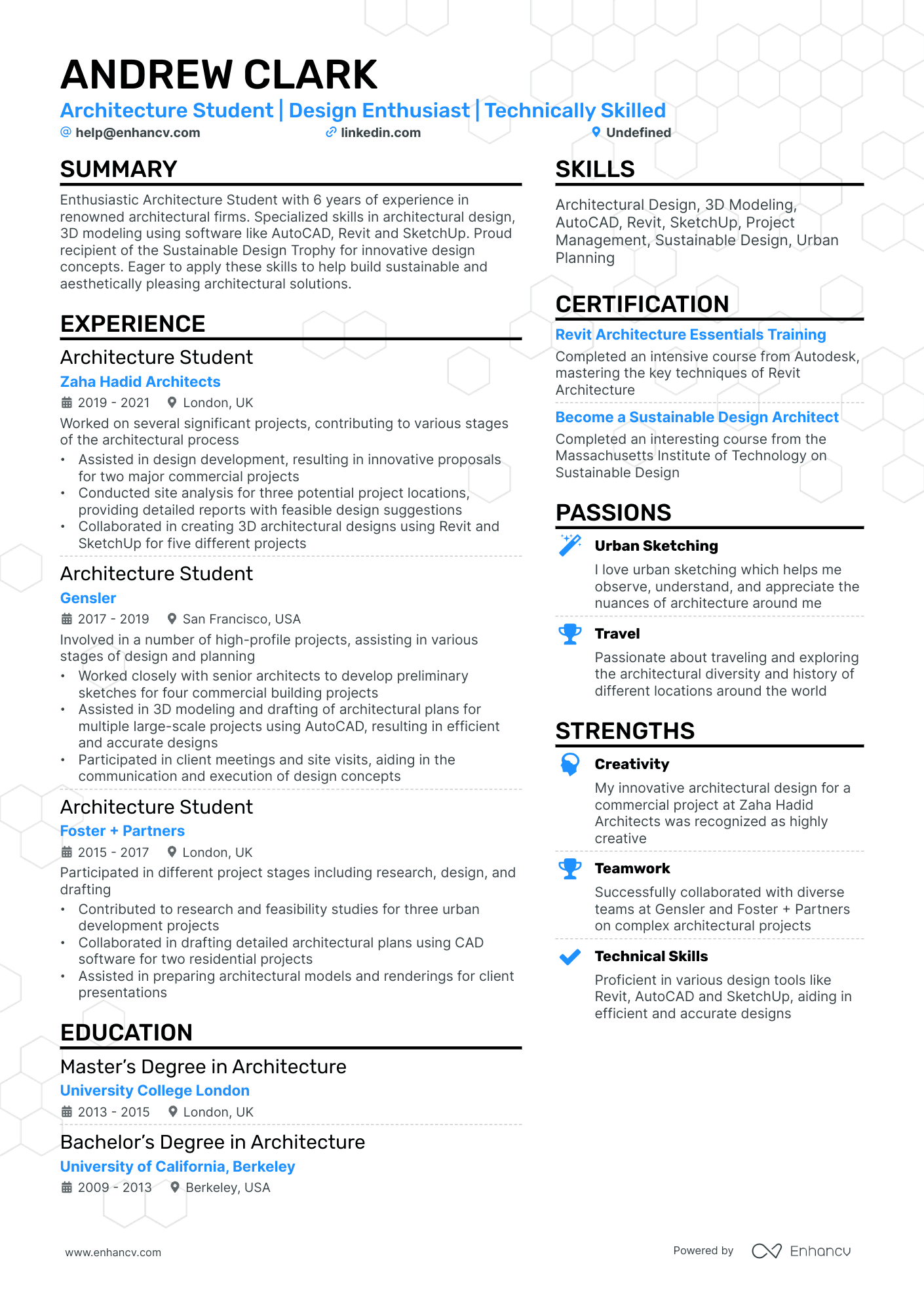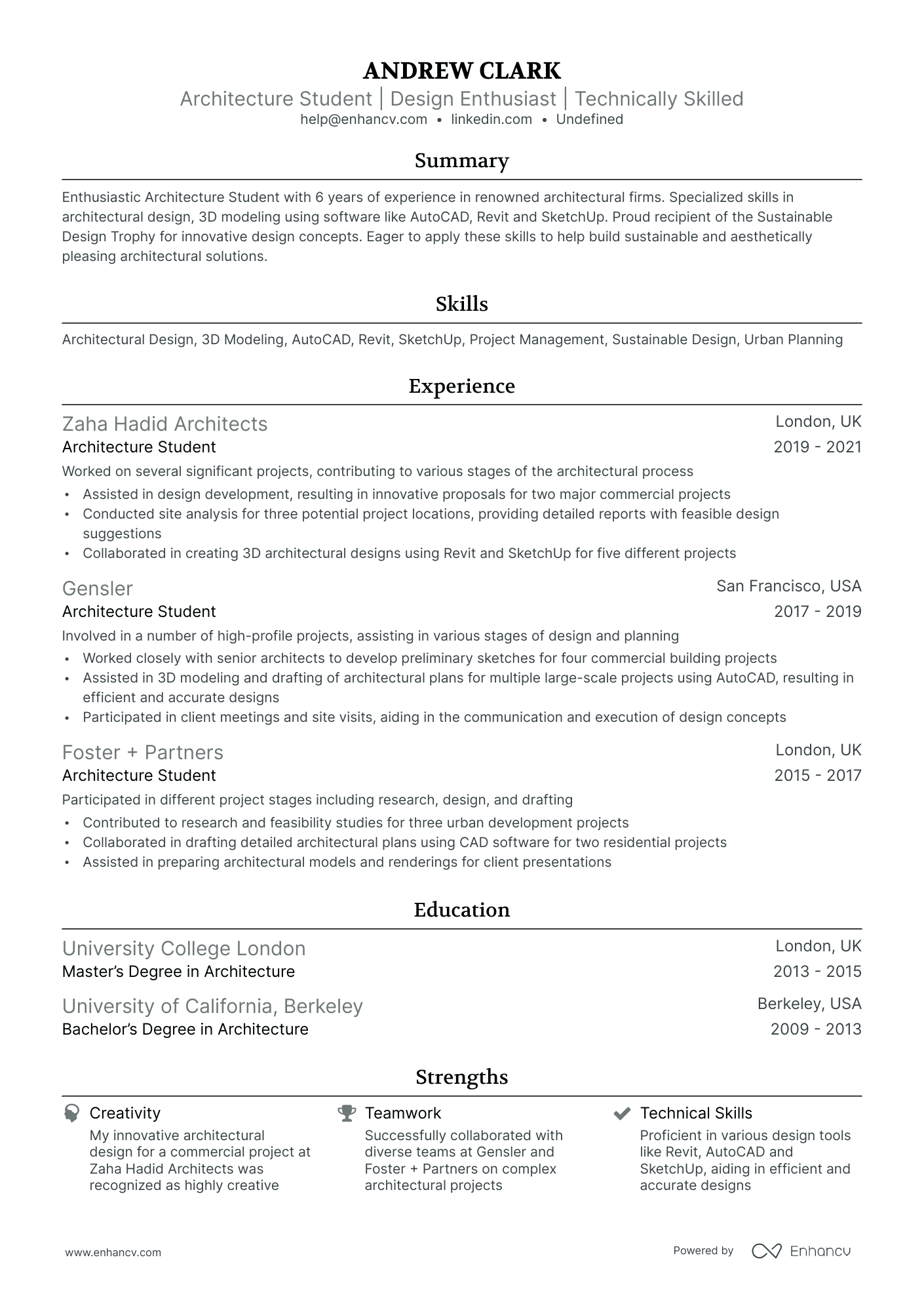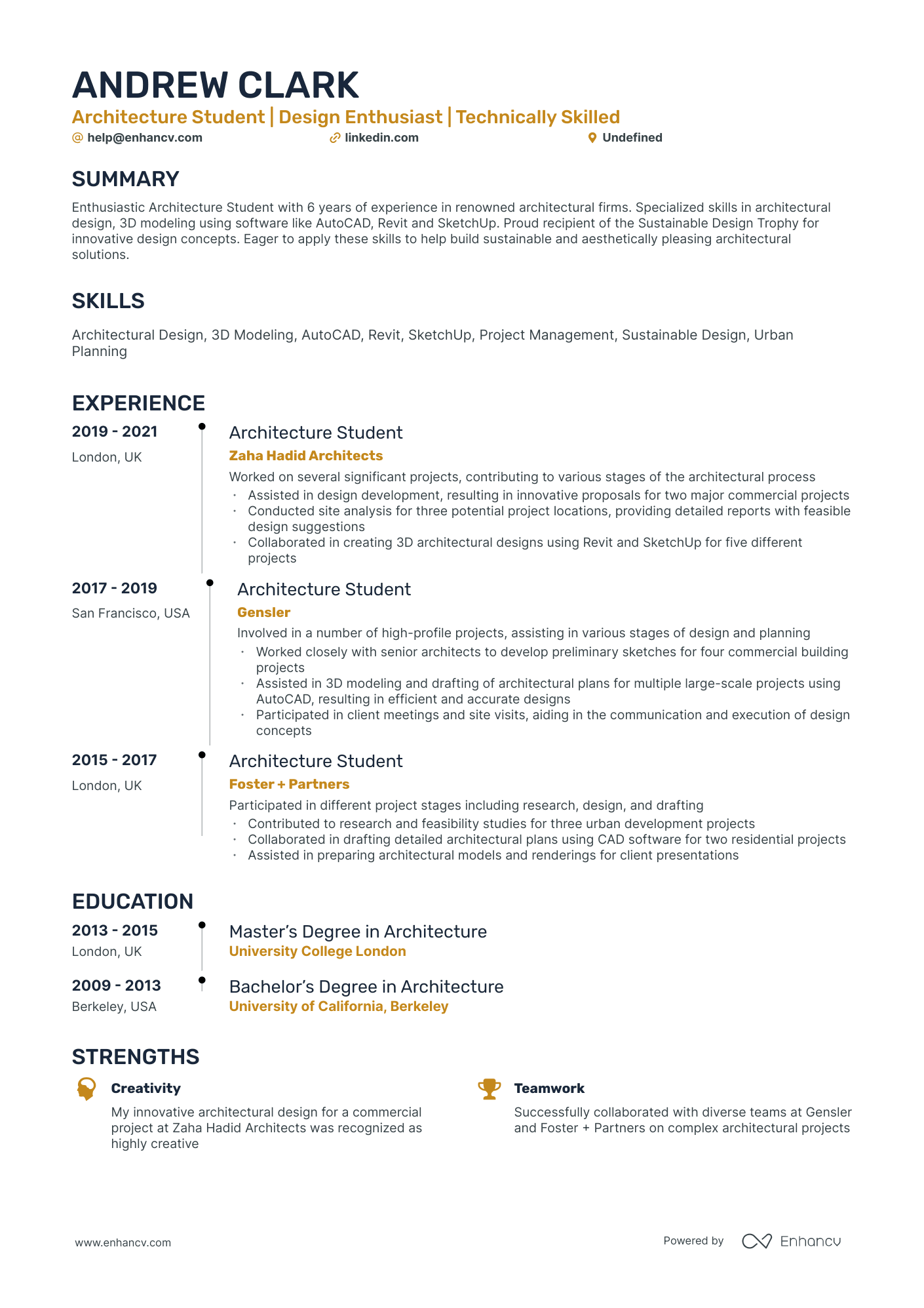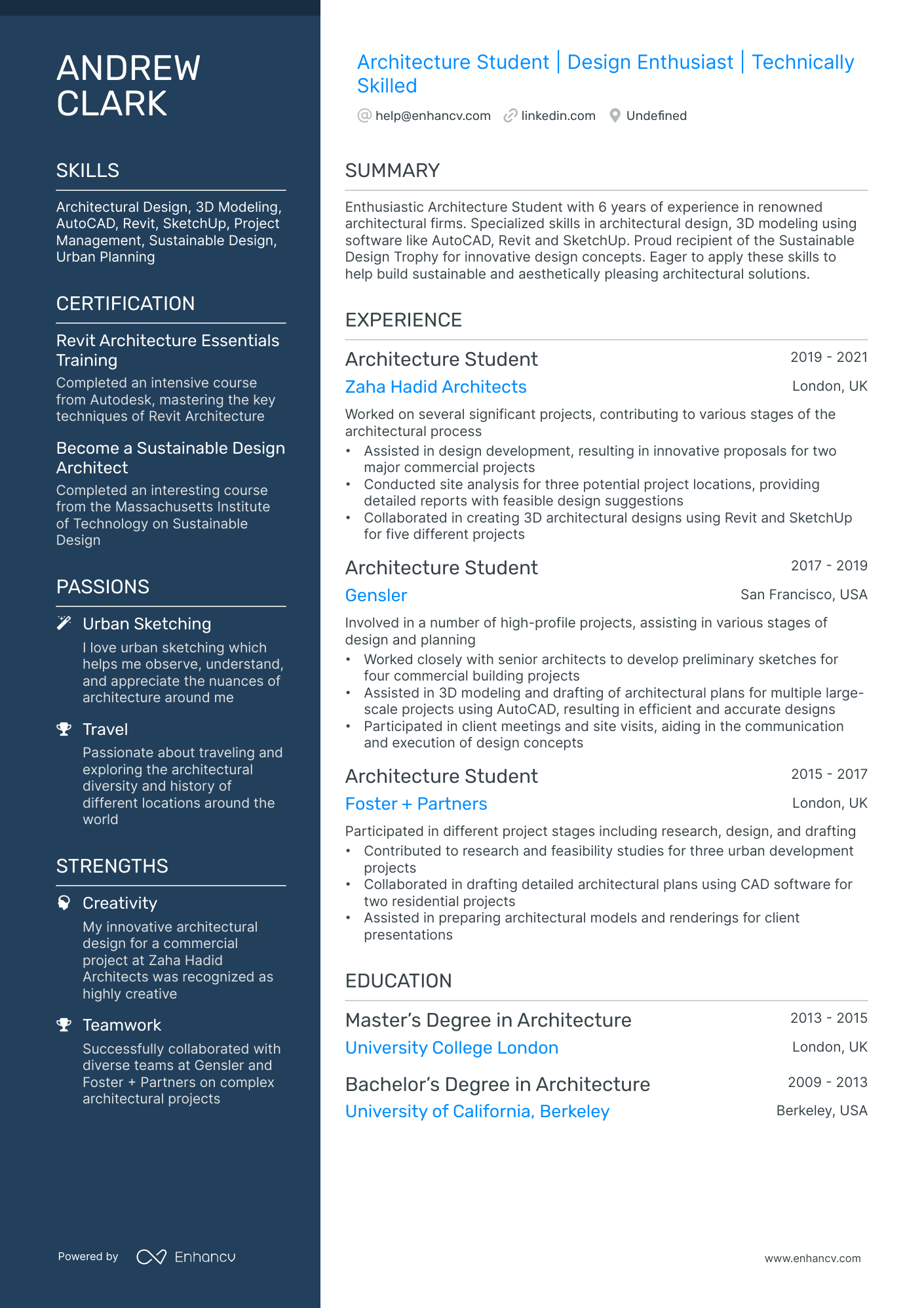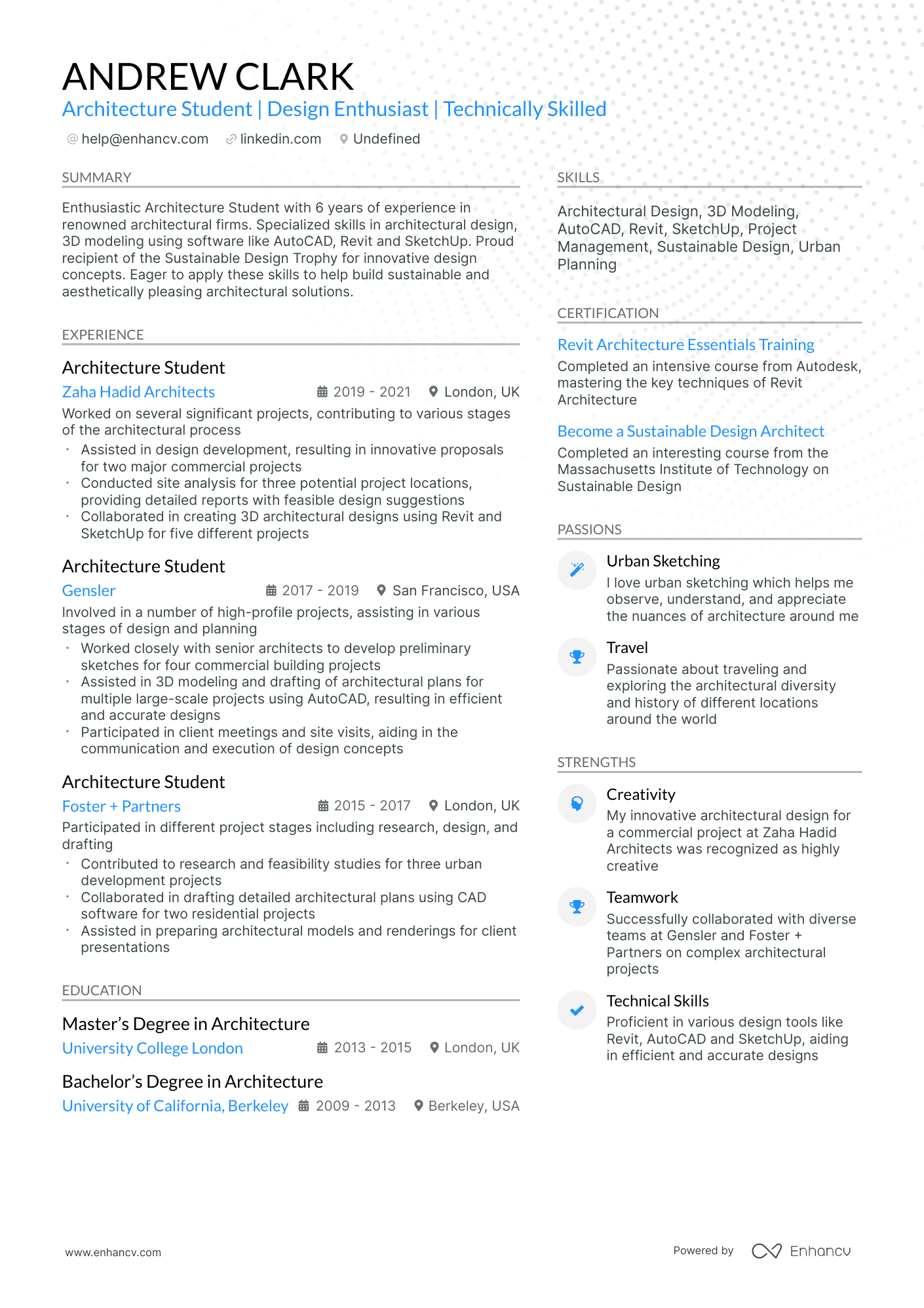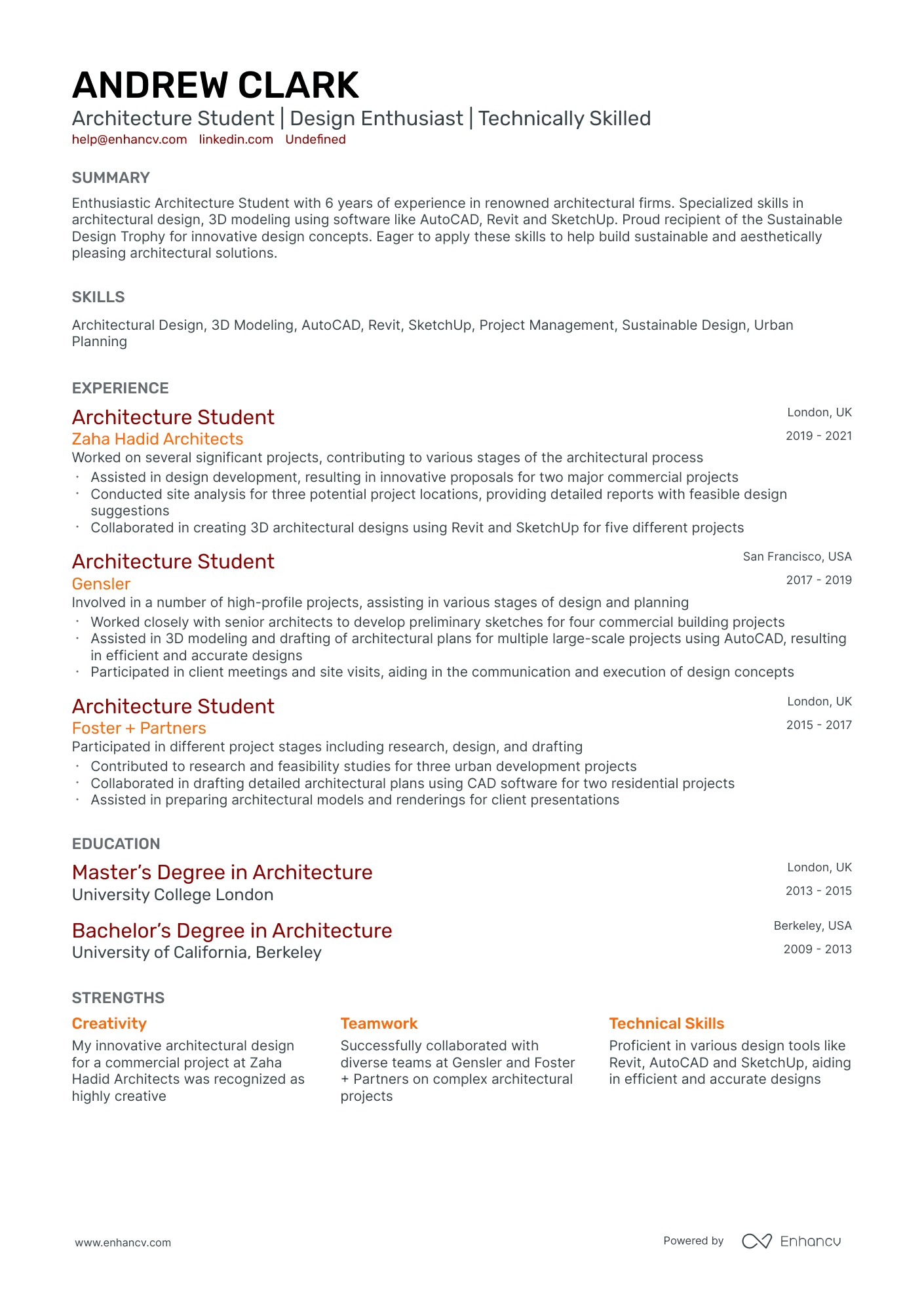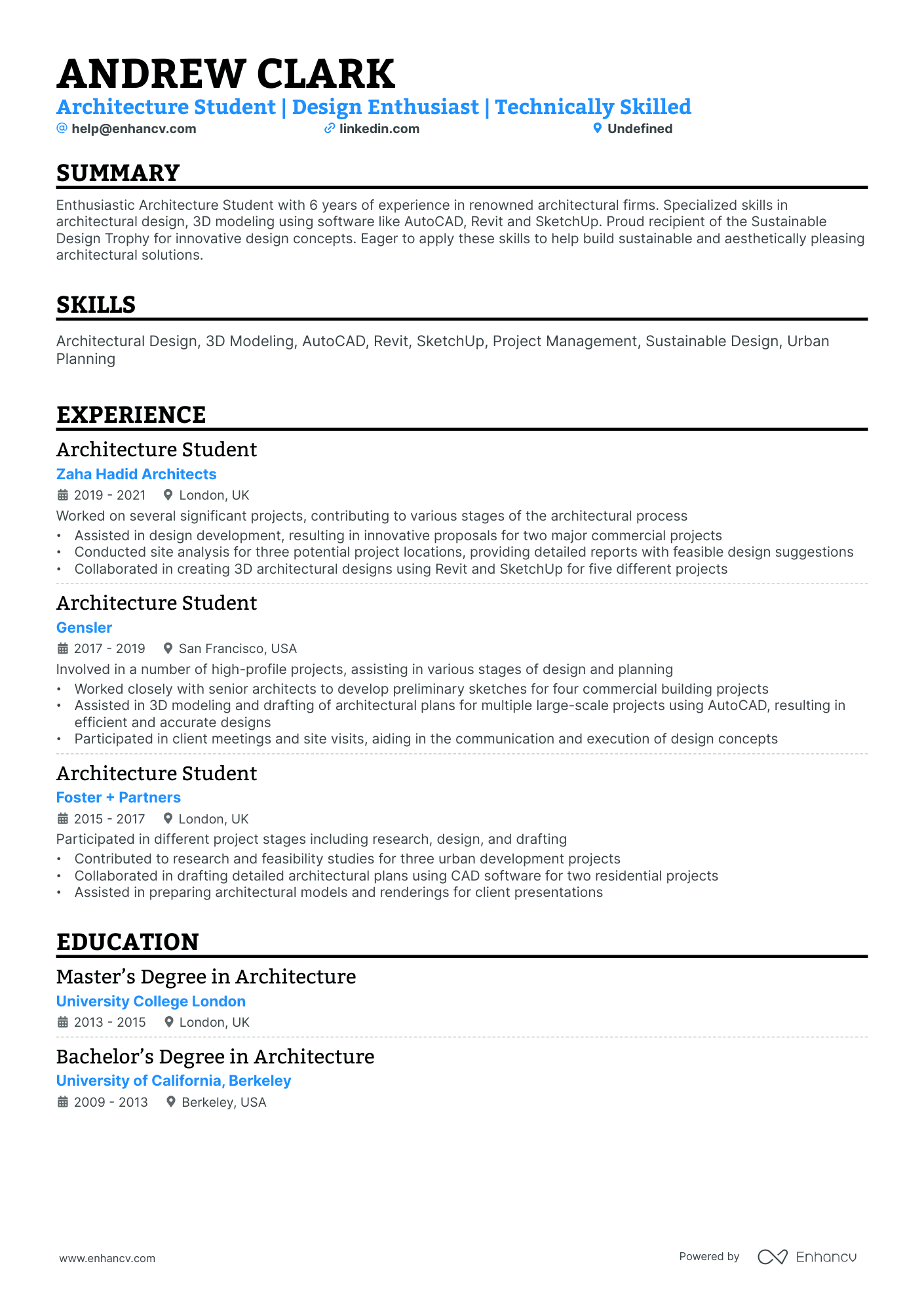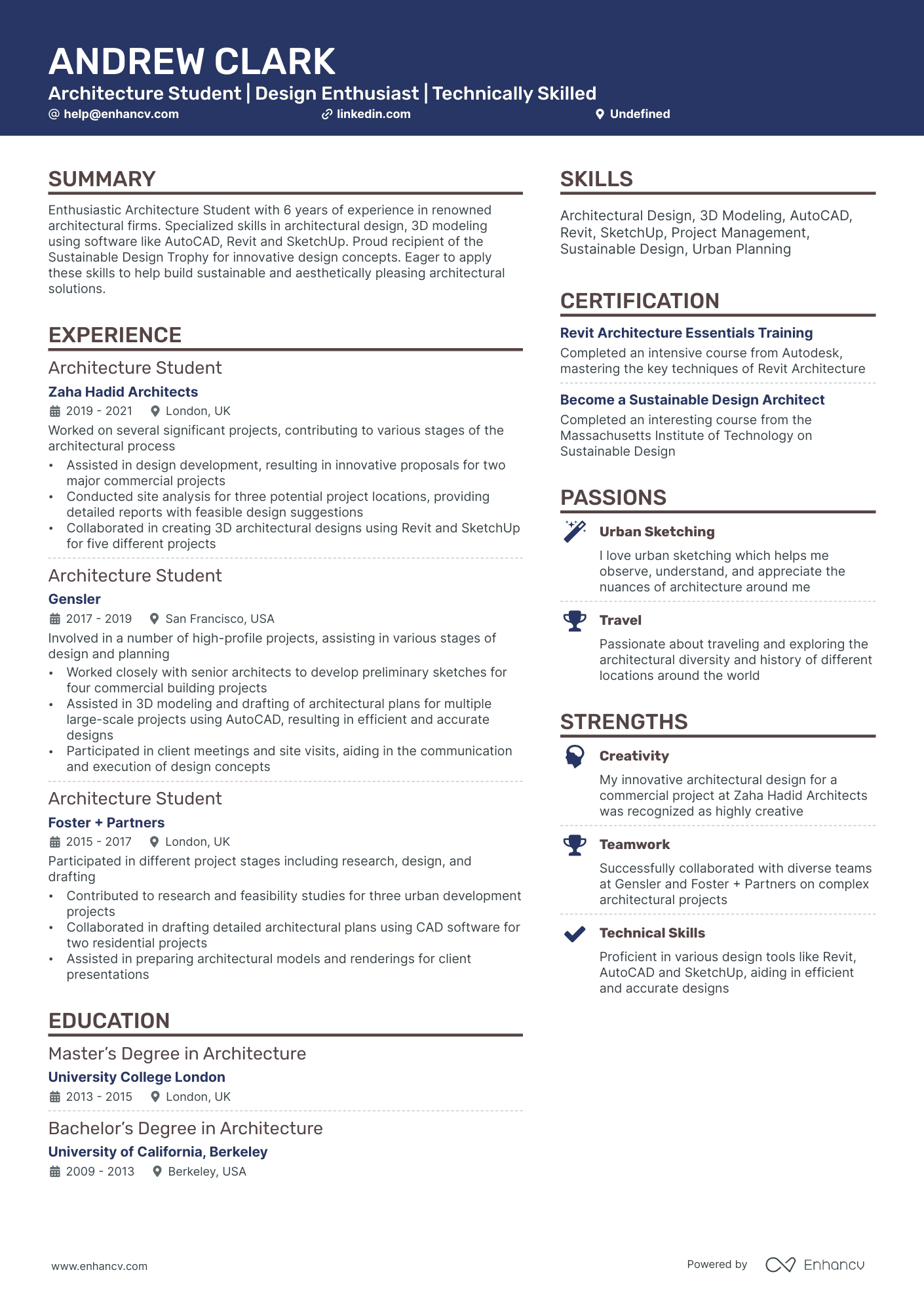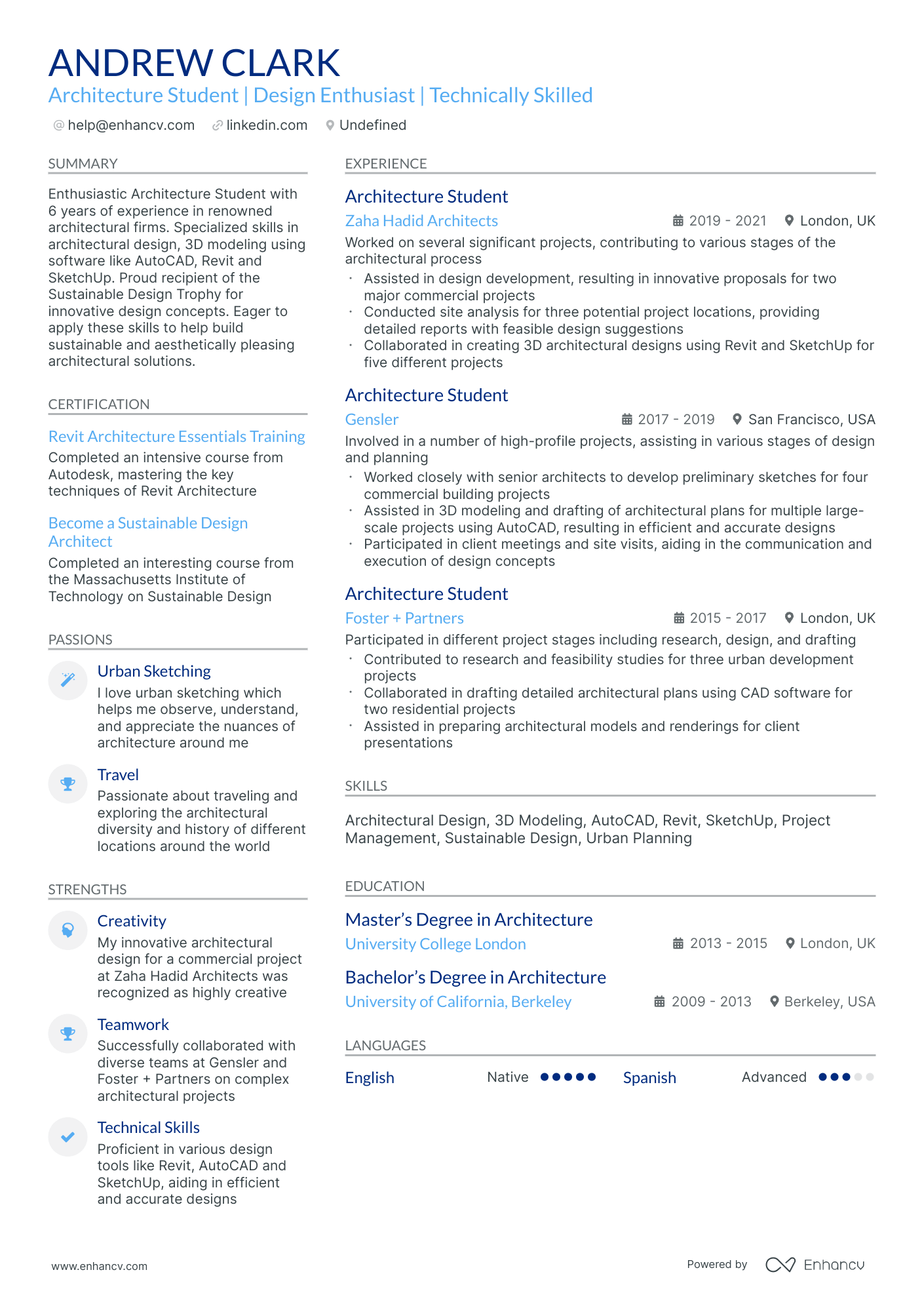Architecture students often struggle with demonstrating their technical skills and design creativity clearly on a two-dimensional resume. Our guide can assist by providing specific tips on incorporating graphics and visual representations of their work, as well as offering advice on how to effectively communicate technical knowledge in an understandable way.
Dive into this guide to uncover:
- Top-tier architecture student resume samples that have successfully landed candidates in leading companies.
- Strategies to direct recruiters' focus towards your standout experiences, notable achievements, and pivotal skills.
- Guidance on crafting resume sections that align closely with the vast majority of job specifications.
- Insights on harmonizing your architecture student technical prowess with your distinct personality, setting you apart from the competition.
Recommended reads:
Simple guide to your architecture student resume format
Successful architecture student resumes all have something in common - candidates invest in a simple resume layout . One that is easy to read, makes a good first impression, and is adapted to their professional experience.
There are three distinct resume formats , which help you focus on different aspects of your resume. Those are:
- A reverse-chronological resume format - puts your most recent experience in the spotlight
- A functional skill-based resume format that makes your transferrable skills the center of attention
- A hybrid resume format - it combines skills and experiences.
What's more, keep in mind that your resume usually goes through an ATS (Applicant Tracker System) (i.e. the software used by companies in the hiring process).
The architecture student resumes that suit the ATS:
- incorporate exact match keywords and skills from the job description;
- should be no longer than two pages;
- should be submitted in a PDF format, unless specified otherwise.
Upload your resume
Drop your resume here or choose a file. PDF & DOCX only. Max 2MB file size.
Pro tip
If you don't happen to have that much relevant experience for the role, you could select a different format for your resume. Popular choices include:
- functional skill-based resume format - that puts the main focus on your skills and accomplishments;
- hybrid resume format - to get the best of both worlds with your architecture student experience and skills.
Essential components for your architecture student resume:
- Header: Feature your name prominently. If you have a notable degree or certification, append it next to your name. Include contact details, a link to your portfolio, and a concise headline.
- Summary or Objective: Align your professional trajectory and standout achievements with the desired role.
- Experience: Craft concise bullet points, highlighting tangible successes and contributions.
- Skills: Showcase them throughout your resume and consider a dedicated sidebar for emphasis.
- Education & Certifications: Reinforce your credibility and demonstrate your commitment to the industry.
What recruiters want to see on your resume:
- Proficiency in architectural software programs: Recruiters often look for proficiency in tools such as AutoCAD, Revit, SketchUp, and Adobe Creative Suite.
- Design portfolio: A well-curated design portfolio can demonstrate your skills, creativity, and understanding of architecture principles. It's often the most important part of an architecture student's application.
- Internship or work experience: Any experience working in an architectural firm or on architectural projects is highly valued as it indicates practical exposure to the field.
- Understanding of architectural theory and history: A strong foundational knowledge in this area shows that you're not only technically proficient but also have a deeper understanding of the field.
- Critical thinking and problem-solving skills: Architecture involves solving complex problems within given constraints, so evidence of strong critical thinking skills is often prioritized.
Recommended reads:
The experience section of your architecture student resume: your professional journey
The experience section is your platform to narrate your professional story. Recruiters scrutinize this section to gauge your unique value proposition.
Here are five steps to craft a compelling experience section:
- Highlight relevant roles, including the company, role description, and tenure, supported by up to six bullet points per role.
- Emphasize tangible outcomes of your contributions, using quantifiable metrics where possible.
- Integrate positive feedback or endorsements to bolster your claims.
- Ensure verb tense consistency when detailing responsibilities.
- Summarize significant achievements relevant to each role.
Explore how seasoned architecture student professionals have crafted their experience sections to secure roles at industry-leading firms.
- Assisted senior architects in designing residential buildings, resulting in the completion of three multi-story apartment complexes.
- Collaborated with a team to develop detailed architectural plans using AutoCAD and Revit software.
- Conducted site visits and analyzed building codes and regulations to ensure compliance with local standards.
- Prepared comprehensive project presentations for client meetings, incorporating 3D modeling and renderings.
- Contributed to the development of sustainable design strategies, incorporating energy-efficient materials and systems.
- Participated in the design and construction administration of a commercial office building, ensuring adherence to project timelines and budget constraints.
- Assisted in conducting feasibility studies and site analysis for potential development projects.
- Collaborated with structural engineers to optimize building structures, resulting in cost savings of over 10%.
- Created detailed architectural drawings and specifications for construction documentation using AutoCAD and SketchUp.
- Engaged in client meetings to discuss design concepts and incorporate feedback into design iterations.
- Led a team of junior designers in the creation of conceptual designs for residential projects.
- Prepared material boards and presentations for client review, resulting in increased project approvals by 20%.
- Collaborated with contractors during the construction phase to address design-related issues and ensure quality control.
- Researched and recommended sustainable building materials and systems, resulting in a 15% reduction in energy consumption.
- Utilized Building Information Modeling (BIM) software to develop detailed architectural models.
- Managed multiple residential renovation projects simultaneously, overseeing project timelines, budgets, and contractor coordination.
- Collaborated with interior designers to integrate aesthetics and functionality into architectural designs.
- Developed innovative design solutions for challenging site constraints, resulting in maximized usable space.
- Implemented sustainable design strategies, including rainwater harvesting and passive cooling techniques.
- Conducted cost analysis and value engineering exercises to optimize project budgets, achieving cost savings of 15%.
- Assisted senior architects in the development of construction documents for commercial and institutional projects.
- Coordinated with consultants, contractors, and vendors to ensure timely completion of project milestones.
- Conducted field surveys and prepared as-built drawings for renovation projects.
- Contributed to the design of accessible spaces, complying with ADA regulations.
- Participated in client meetings to gather requirements and present design proposals.
- Collaborated with landscape architects to integrate site planning and environmental sustainability into architectural designs.
- Developed detailed construction drawings, schedules, and specifications for high-end residential projects.
- Implemented Building Information Modeling (BIM) workflows, resulting in improved coordination among project teams.
- Conducted on-site quality inspections to ensure compliance with design intent and specifications.
- Assisted in the selection and sourcing of materials and finishes, considering both aesthetics and durability.
- Led a team of architects and engineers in the design and development of a large-scale mixed-use project.
- Coordinated with consultants to integrate structural, mechanical, and electrical systems into architectural plans.
- Managed the preparation and submission of permit applications and construction documentation.
- Developed innovative strategies for sustainable design, including green roofs and solar panel integration.
- Participated in public presentations and community engagement sessions to gather feedback and address concerns.
- Conducted research on emerging architectural trends and technologies, incorporating findings into design proposals.
- Prepared detailed cost estimates and budgets for residential and commercial projects.
- Collaborated with interdisciplinary project teams to develop comprehensive design solutions.
- Contributed to the production of marketing materials and presentations for client pitches.
- Engaged in continuous professional development through workshops and seminars.
- Managed architectural projects from concept to completion, overseeing all design and construction phases.
- Collaborated with clients to define project requirements and develop design briefs.
- Coordinated with contractors and subconsultants to ensure adherence to project schedules and specifications.
- Implemented sustainable design principles, resulting in LEED Gold certification for a commercial building.
- Conducted post-occupancy evaluations and addressed any design-related issues.
- Provide freelance architectural design services for residential and small-scale commercial projects.
- Develop comprehensive architectural drawings and specifications using industry-standard software.
- Collaborate with clients to understand their vision and incorporate it into the design process.
- Manage project budgets and timelines to ensure successful project delivery.
- Stay updated with the latest trends and technologies in architecture through continuous learning.
Quantifying impact on your resume
<ul>
Navigating the resume landscape without experience
It's not uncommon for candidates lacking direct experience to secure entry-level positions. Their resumes often share these characteristics:
- They opt for a functional or skill-based format, emphasizing strengths over chronological work history.
- Transferrable skills, gleaned from diverse life and work experiences, take center stage.
- The objective section melds career highlights, the motivation behind the application, and the unique value proposition for the role.
- Skills are tailored to meet basic job prerequisites while also spotlighting any specialized expertise.
Recommended reads:
Pro tip
Remember, the experience section isn't just about traditional roles. It's a space to highlight all professional learning, whether from internships, contract roles, research projects, or other relevant experiences. If it's added value to your skill set for the architecture student role, it deserves a mention.
Spotlighting your architecture student hard and soft skills
Hard skills denote your technological proficiency and expertise in specific tools or software. These skills are often validated through certifications and hands-on experience.
Soft skills, on the other hand, reflect your interpersonal abilities and how you navigate workplace dynamics. These skills are cultivated over a lifetime and can be more nuanced.
Why the emphasis on both? Hard skills demonstrate your technical competence and reduce training needs. Soft skills suggest adaptability and cultural fit.
To optimize your skills section:
- Forego basic skills like "Excel" in favor of more specific proficiencies like "Excel Macros".
- Highlight core values and work ethics as soft skills, indicating what you prioritize in a professional setting.
- If relevant, create a distinct section for language proficiencies.
- Balance hard and soft skills by crafting a strengths or achievements section, illustrating outcomes achieved through both skill sets.
To assist you, we've curated a list of skills highly sought after by recruiters. Ensure you integrate those that resonate with your expertise and the prospective employer's needs:
Top skills for your architecture student resume:
AutoCAD
Revit
SketchUp
Adobe Photoshop
Adobe Illustrator
3D Modeling
Building Information Modeling (BIM)
Grasshopper
Rhino
Microsoft Office Suite
Critical Thinking
Communication
Time Management
Teamwork
Creativity
Attention to Detail
Problem Solving
Project Management
Adaptability
Interpersonal Skills
Pro tip
Consider dedicating a separate skills section on your architecture student resume to showcase your technical proficiencies, especially if you want to highlight specific software expertise.
Architecture student resume: certifications and education
Boost your architecture student resume by:
- Featuring recent and relevant certificates.
- Listing basic details: certificate name, school, and dates.
- If you lack experience, highlight skills from your education.
- Only include valid license numbers if needed.
Job ads often list desired education and certificates. Match these with top industry certificates.
Best certifications to list on your resume
Pro tip
If a particular certification is highly valued in the industry or by the company, consider highlighting it in your resume's headline.
Recommended reads:
Crafting the architecture student resume summary or objective: a blend of achievements, aspirations, and uniqueness
Whether you opt for a resume summary or objective depends on your career trajectory.
- If you have a rich tapestry of relevant achievements, a resume summary can spotlight these accomplishments.
- If you're relatively new or transitioning, a resume objective can articulate your aspirations and how they align with the role.
Regardless of your choice, this section should encapsulate your unique value proposition, blending your technical and interpersonal strengths.
Resume summary and objective examples for a architecture student resume
- Seasoned architect with 7 years of experience specializing in sustainable urban planning and design. Expertise in Autodesk AutoCAD, SketchUp, and Adobe Creative Suite. Recognized for a major city revitalization project positively impacting over 200,000 residents.
- Highly skilled architect boasting a decade-long career developing award-winning residential and commercial spaces. Comprehensive knowledge of Revit, BIM, and 3D modeling. Led a team that won the prestigious Architecture MasterPrize in 2022.
- Determined mechanical engineer keen to transfer her 8-year technical expertise into architecture. Proficient in CAD software, with a solid foundation in structural integrity and functionality considerations. Spearheaded a project redesigning factory spaces that boosted productivity by 30%.
- Retail manager aiming to leverage his 6 years of team leadership and strategic planning skills within the architectural realm. Experience in planning and executing store layouts optimizing customer flow. Successfully increased sales revenue by 20% through effective spatial arrangement.
- Recent graduate in Urban Planning seeking an entry-level architecture position. Eager to apply knowledge of zoning laws, environmental impact assessments, and urban design principles. Adept in using GIS tools and committed to creating sustainable and community-centered urban environments.
- Passionate about sculptural design, adept in 3D modeling software, and freshly graduated from the School of Architecture. Aim to leverage academic knowledge and strong analytical skills to contribute in a professional architectural setting, focusing on creating designs that resonate with client visions while adhering to safety standards.
Enhancing your architecture student resume with additional sections
Make your architecture student resume truly distinctive by adding supplementary sections that showcase:
- Awards that underscore your industry recognition.
- Projects that bolster your application's relevance.
- Hobbies, if they can further your candidacy by revealing facets of your personality.
- Community involvement to highlight causes you champion.
Key takeaways
- Craft a architecture student resume that's easy to read and aligns with the role's requirements.
- The top third of your resume should clearly convey your unique value proposition for the architecture student role.
- Tailor your resume to the job, highlighting skills, achievements, and the tangible results of your efforts.
- Detail your certifications and technical skills to demonstrate proficiency with specific tools and technologies.
- The sections you choose should collectively present a comprehensive view of your professional expertise and personality.
